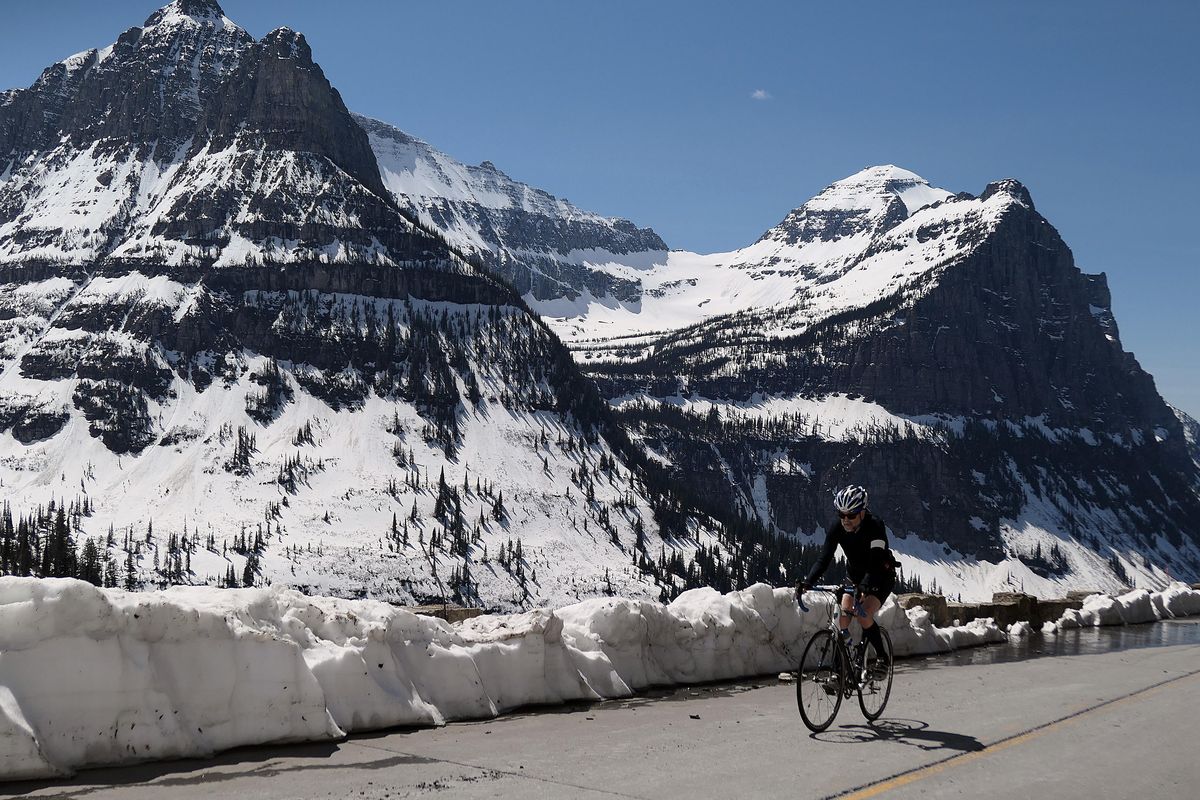Pedaling perfection: Cycling Montana’s Going-to-the-Sun Road

GLACIER NATIONAL PARK – On a perfect day for a bike ride, I was in the perfect place.
With temperatures in the low 70s under bluebird skies, I found myself climbing the iconic Going-to-the-Sun Road, not a car in sight.
It’s becoming a springtime tradition for cyclists in Montana. As crews begin clearing the winter snow, the park opens the lower sections of the iconic roadway to hikers and bikers, granting human-powered access to one of America’s most beautiful places.
If you hit it right, the weather is great, the scenery unbelievable, and you never have to worry about traffic.
Your only worries are keeping your speed down on your descent, the occasional avalanche and — this being Glacier — grizzly bears.
As I topped out near the Triple Arches area not far from Logan Pass, I looked over at another cyclist who was just as blown away as I was, a moment of shared Rocky Mountain bliss.
“This is so amazing!” I said, unable to contain myself.
“It’s definitely the highlight of my year,” he said in return.

If you want to get in on this amazing ride, you still have time. The road isn’t scheduled to open for automobile traffic until June 22 at the earliest, park officials said.
And if you like the idea of cycling in a spectacular national park that’s a little closer, the roads at Mount Rainier also offer springtime adventures with light, or even no traffic.
Risks and rewards
The ride up Going-to-the-Sun Road isn’t without risks, particularly on the cliffy western side of Logan Pass. Last week, 13 cyclists were stranded for about eight hours after an avalanche blocked the highway in the Triple Arches area, the same place I had topped out just weeks before.
Nobody was hurt, and park crews were able to clear a path through the slide after it stabilized.
Bears are another hazard. As Glacier’s grizzlies wake up from the long winter, they often walk along roadways, said Lauren Alley, spokeswoman for the park.
With no automobile traffic to scare them away, cyclists sometimes have some uncomfortable encounters. That’s why the park advises riders to carry bear spray and know how to use it.
“It’s not a requirement,” Alley said. “But it could save your life.”
Other common-sense safety equipment includes a helmet, with rockfall a concern along some of the steep cliff sections.
“The best and easiest things people can do to lower their overall risk is wear a helmet, reduce speed and watch for rocks,” Glacier Superintendent Jeff Mow said in a statement.
For me and a lot of other riders, clothing was difficult to gauge. The ride begins at Avalanche Creek, 15.5 miles from the west entrance and just below 4,000 feet in elevation. The climb can feel hot as it gains more than 2,000 vertical feet before snow blocks the road.
Once you start down, the cool mountain air can feel downright chilly when you’re not working hard. Consider bringing a jacket for the descent.
While most riders attack it from the west side, the Going-to-the-Sun Road is also open to cycling and hiking on the east side near St. Mary Lake.
“You have many fewer riders over there and many more bears,” Alley said.
Before Logan Pass can open to automobile traffic, snowplow crews clear the road from west and east. The plowing goes relatively quickly until they get to the “Big Drift” at Logan Pass, a giant snow patch that is up to 80 feet deep, Alley said.
This year, crews will also work on patching and preserving the pavement of the iconic 1933-era highway, which has been featured in such classic films as “The Shining” (1980) and “Forrest Gump” (1994).
“We definitely won’t open before June 22,” Alley said. “It may be later depending on weather.”
Cycling at Mount Rainier
The road to Sunrise in Mount Rainier National Park is a popular cycling climb, rising nearly 3,000 vertical feet and topping out at 6,400 feet, the highest drivable place in the park.
Like the Going-to-the-Sun Road, the Sunrise road is cleared of snow every spring to get ready for the busy summer season. Unlike its Glacier National Park cousin, recreational access is much more limited at Sunrise.
Most weekdays, the road is closed to all hikers and bikers as crews do their work. It does open for recreational use occasionally on weekends, park officials said. Currently, seven miles of the road are open to all traffic from the park entrance to White River Campground, a lovely and mostly untraveled route.
I arrived at the White River entrance last week hoping to ride the road to Sunrise, but it was closed to recreational traffic. Instead, I rode from White River Campground to Cayuse Pass (4,675 feet) on Mather Memorial Parkway (State Route 410) for a 20-mile roundtrip that offers great views of the eastern side of Mount Rainier.
On weekdays, the SR410 is lightly traveled by automobiles, and cyclists regularly ride the route. Riders can also tackle Chinook Pass, about 3.5 miles away from Cayuse Pass and another 800 vertical feet higher.
Elsewhere in Mount Rainier National Park, two roads remain closed to vehicle traffic and offer mountain bikers some excellent options. The Westside Road near the Nisqually entrance on the park’s southwest side is an unpaved hiker-biker route that travels 19 miles round-trip at lower elevations.
And the Carbon River Road on Mount Rainier National Park’s northwest side offers 5 miles of hiker-biker travel to the Ipsut Creek Trailhead, which accesses the Wonderland Trail. In 2006, major floods washed out the road, and the park chose to leave it as a hiker-biker-only route.